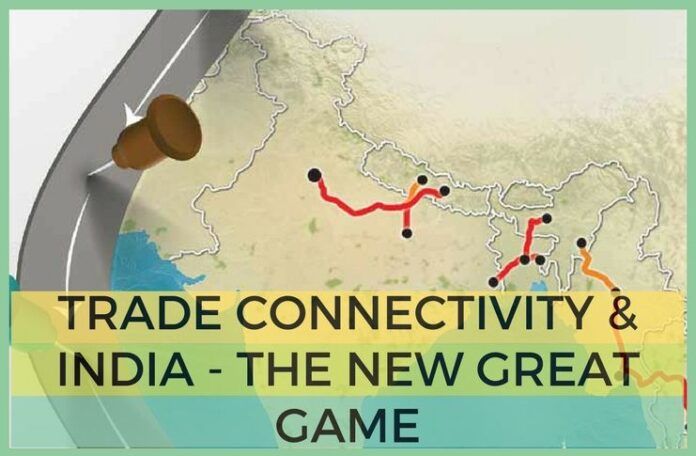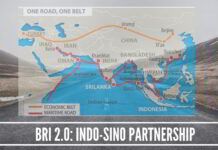
With Trade connectivity in place, 21st century will be Asian Century
[dropcap color=”#008040″ boxed=”yes” boxed_radius=”8px” class=”” id=””]A[/dropcap]s a Logistics professional, this is the continuation of writings to your good self at PGurus to highlight the dire need to attract the urgent attention of Govt of India on the importance of Logistics infrastructure creation as part of our National Quest for consistent Economic growth.
As World slips into De–globalisation mode, the new Blitzkrieg in Global Trade Wars would be the rapid creation of regional Transborder and transcontinental connectivity’s with the Great Power Games likely to be played by both India and China to crack the logic of geography and create new paradigm shifts in regional geoeconomics
As Global Trade War clouds loom large on the horizon, India, unfortunately, has not even begun its quest to quickly build the necessary basic Logistical infrastructure to fire its industrial manufacturing productivity on a scale needed to create Jobs and economic growth in a vast country like India.
True India has Manufacturing / Agriculture / Services & Exports as the 4 important engines to fuel its overall GDP growth but it’s clear for anybody who follows these subjects that 3 out of the 4 segments cannot progress at sufficient pace without adequate Logistical infrastructure creation both within India and without bridging geographical connectivity between India with rest of the world which acts as natural barriers to economic growth.
[dropcap color=”#008040″ boxed=”yes” boxed_radius=”8px” class=”” id=””]R[/dropcap]ecent news reports suggest how the Govt of India is growing wary of the multibillion dollar One Belt One Road Chinese initiative in expanding the regional Trade connectivity and co-operation with the rest of Eurasia but while these concerns do have geopolitically strategic security and economic implications its painfully evident that successive Indian Governments over the years have all failed to understand the importance of creating Logistical infrastructure in promoting Trade and Commerce connectivity for boosting economic growth within the Indian subcontinent.
So it’s only natural PM Shri Narendra Modi Ji hailing from Gujarat rated among the leading traditional mercantile communities of South Asia has lent a new urgency to these trade connectivity projects
Many recent announcements and initiatives by Govt of India show the intent to progress on this path swiftly but alas the speed of implementation has indeed left India with very limited options and will seriously impact India’s growth patterns and leave unplugged gaping holes which will only further lead to Slowing of economic growth and inability of India to compete on a global scale among leading Nations of the World.
5 Key massive Logistical infrastructure projects are undertaken on a Mission Mode with 365x24x7 Work till completion initiative for the next 5 Years could unlock huge economic growth prospects for the entire Indian subcontinent:
1. BBIN ( Bangladesh Bhutan India Nepal ) Transport Agreement initiative must be connected with Dedicated high-speed Road / Rail Freight Transport Corridors to ensure the seamless movement of Goods & Services with no Trade regulatory barriers hindering Cross Border Trade progress.
2.The India – Myanmar – Thailand ( IMT) trilateral highway, which entails linking India to Myanmar and then further to the Southeast Asia as part of India’s Act East policy has been taken up as top priority by Govt of India but very slow progress achieved thus far on creating the necessary physical infrastructure to support this trade promotion initiative. “The India-Myanmar-Thailand road link has been designed to bridge emerging economies in the Asean and Saarc regions and hence the speedy creation of this Road Link infrastructure will establish effective and credible infrastructure links to swiftly enhance regional trade co-operation between South Asia and Southeast Asia.
3.India-Sri Lanka Trade Bridge has been in the works to build a Sea bridge and tunnel connecting Sri Lanka for a seamless flow of traffic and passenger vehicles.“The Asian Development Bank (ADB) is ready to fully finance a bridge-building project connecting India to Sri Lanka and if GOI can focus boldly on transborder Energy & Transport connectivity’s with Sri Lanka on the strategically important Indian Ocean region it will surely be the potential economic game changer for the entire Indian subcontinent.
4. International North South Transport Corridor: Given India’s strategic interests in the West and the Central Asian region, and the dire need for greater economic and energy cooperation between South, Central and the West Asian regions, the GOI must now step up its engagement to re-connect with its extended neighbourhood for enhancing Trade and commerce. Considering the stakes in INSTC for India it must take the lead in addressing the bottlenecks and constraints of all the Member States so the full potential of the INSTC is realised and from India’s point of view, this corridor would not only help India bypass Pakistan and yet reach out to Central Asia and Russia, but also enable it to transport goods at cheaper costs to the European markets. In addition, the Indian exports could also potentially get a competitive advantage due to lower costs and lower delivery times. The potential of this corridor will be manifolds for India if linked with the South-east Asian countries.
5. Deep Sea Ports on Eastern Coast of India: To boost trade connectivity between SAARC and South East Asia markets and to capitalise on the booming intra-Asia trade, GOI must build key port infrastructure on India’s eastern coast and strengthen its Act East policy. As India plans to triple cargo handling capacity at its ports to 3.13 billion tonnes by 2020 to meet demand, the strategic setting up of Deep Sea Ports on its Eastern Coast will ease Cargo handling pressure capacity on its Western gateway Ports of India.
[dropcap color=”#008040″ boxed=”yes” boxed_radius=”8px” class=”” id=””]S[/dropcap]agarmala Project, another ambitious plan envisaged by the Ministry of Shipping , GOI with fourteen Coastal Economic Zones (CEZ) across the major and non-major ports of India to support the Govt’s Make in India initiative is expected to not only to reduce logistics costs by optimising the movement of cargo but also impact competitiveness in availability or raw materials, skills, supporting the logistics infrastructure and to facilitate Port led industrial agglomeration in India.
However, without sustained concerted efforts by GOI to address the various bottlenecks and clear the decks for timely implementation, all of these massive infrastructure projects will only remain as ambitious drawing board plans and eventually, lead to unfulfilled trade connectivity initiatives by Govt of India.
Post the global financial crisis, received wisdom from Economic experts has it that while China is trying to rejig its growth model away from its excessive dependence on investment towards more Consumption led growth, India needs to focus more on investment-led GDP growth to create new increased production capacity / more employment / higher demand which will in the long term lead to more consistent sustained economic growth.
Finally some historical perspectives, during ancient times Hindustan were the masters of the seaborne trade of Europe, Asia and Africa & the Hindu mercantile community on the Coastal belts were very enterprising and quite well known for their entrepreneurship, trustworthiness and resilience.To facilitate trade and commerce royal roads were constructed all over the country from east to west and from north to south with the river Ganga and its tributaries used for carrying the goods and the great sea-ports of Western & Eastern India carried extensive trade with China, Ceylon, Java and Sumatra and the Middle East.
[dropcap color=”#008040″ boxed=”yes” boxed_radius=”8px” class=”” id=””]S[/dropcap]o it’s only natural PM Shri Narendra Modi Ji hailing from Gujarat rated among the leading traditional mercantile communities of South Asia has lent a new urgency to these trade connectivity projects and it could yet become the most powerful symbols of the subcontinent’s new regionalism. Promoting connectivity, within and across national boundaries, has been a major priority for Prime Minister Narendra Modi and hope it can swiftly end India’s sleepwalking on regional connectivity by implementing these Projects and re-establish the Indian subcontinent among premier economically vibrant regions in the World.
As World slips into De–globalisation mode, the new Blitzkrieg in Global Trade Wars would be the rapid creation of regional Transborder and transcontinental connectivity’s with the Great Power Games likely to be played by both India and China to crack the logic of geography and create new paradigm shifts in regional geoeconomics …..who knows at the end of it all the two ancient Civilisational partners India & China will both learn to accept each other as equal partners to stable World economic growth and will truly usher in the belief that 21st Century is going to be the Asian Century.
Note:
1. The views expressed here are those of the author and do not necessarily represent or reflect the views of PGurus.
- Why India should have different players for different formats - November 26, 2021
- India’s Trade Policy Blues - April 12, 2021
- The idea of a Modern Secular Bharat– Part 2 - October 9, 2018










Very interesting and useful article. Lots of such ideas are needed. Hope the Government is listening to all such ideas coming up in the media.
Such ideas should also address the issues of how the Government can fund such projects, and do so viably. Economics is not doing eveything in every realm. Resources, esp finance, being scarce, the ideas should also address financial viability and sourcing finance viably. If cost-benefit comparison can also be broadly indicated, it will help.